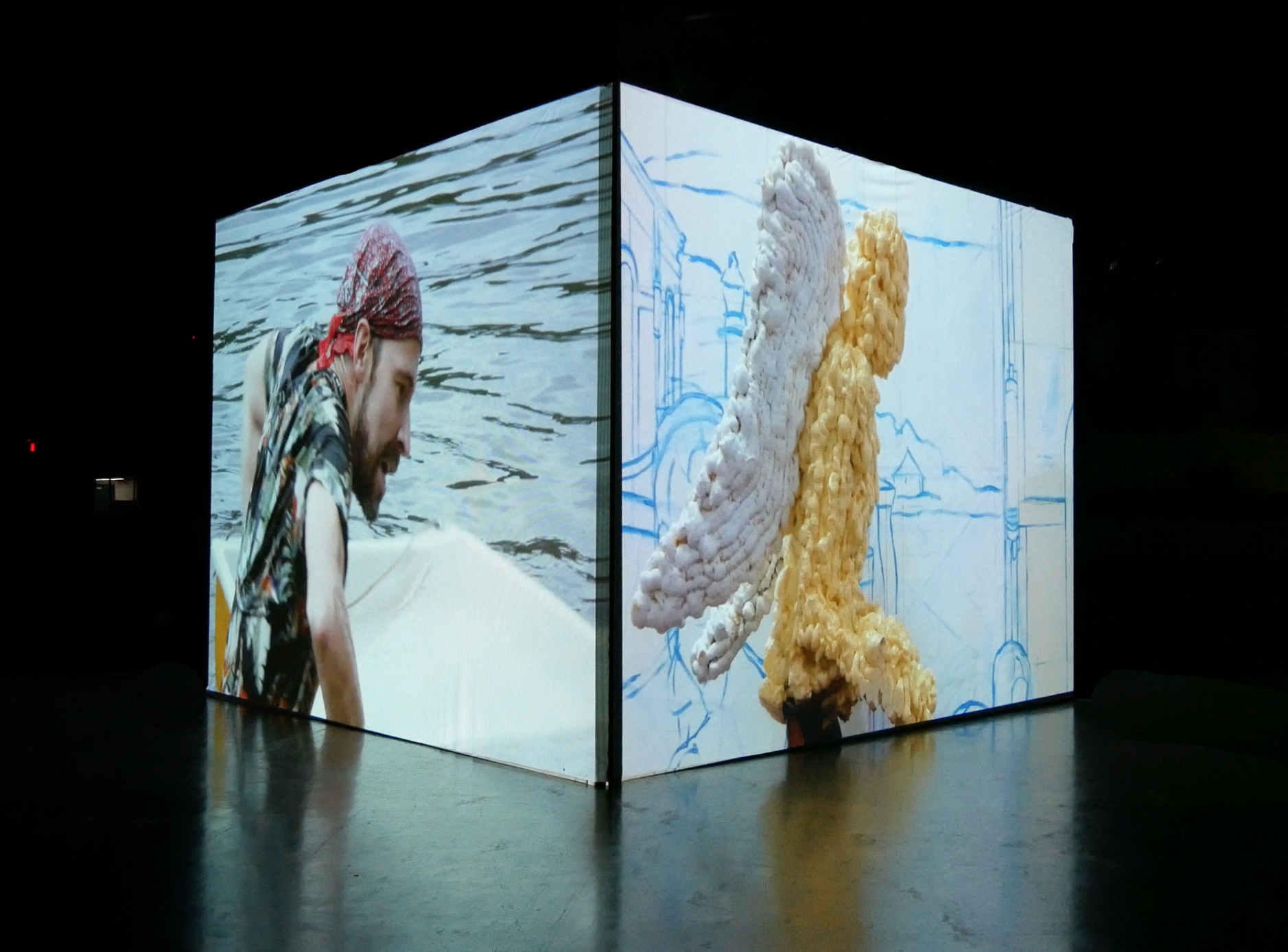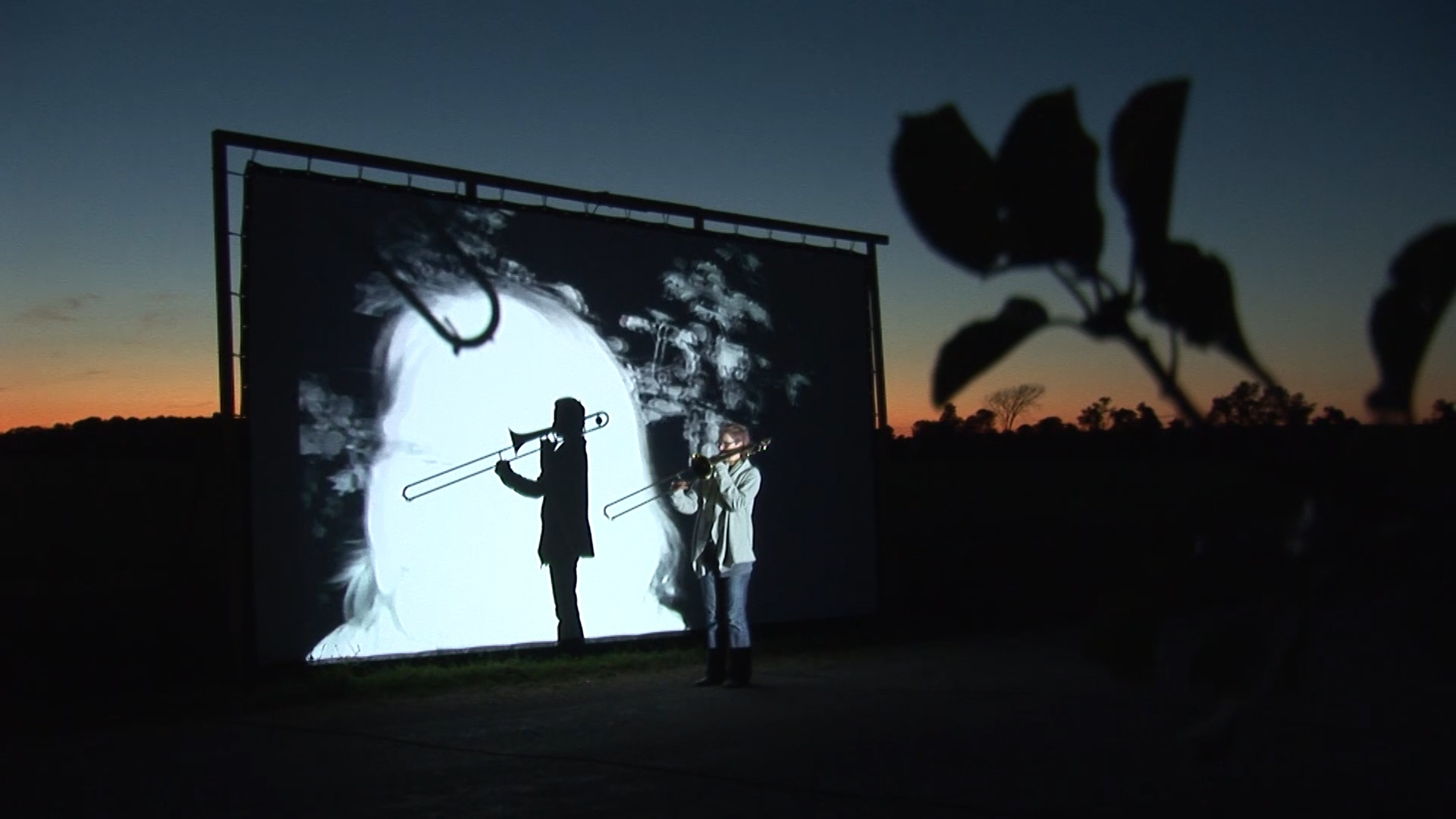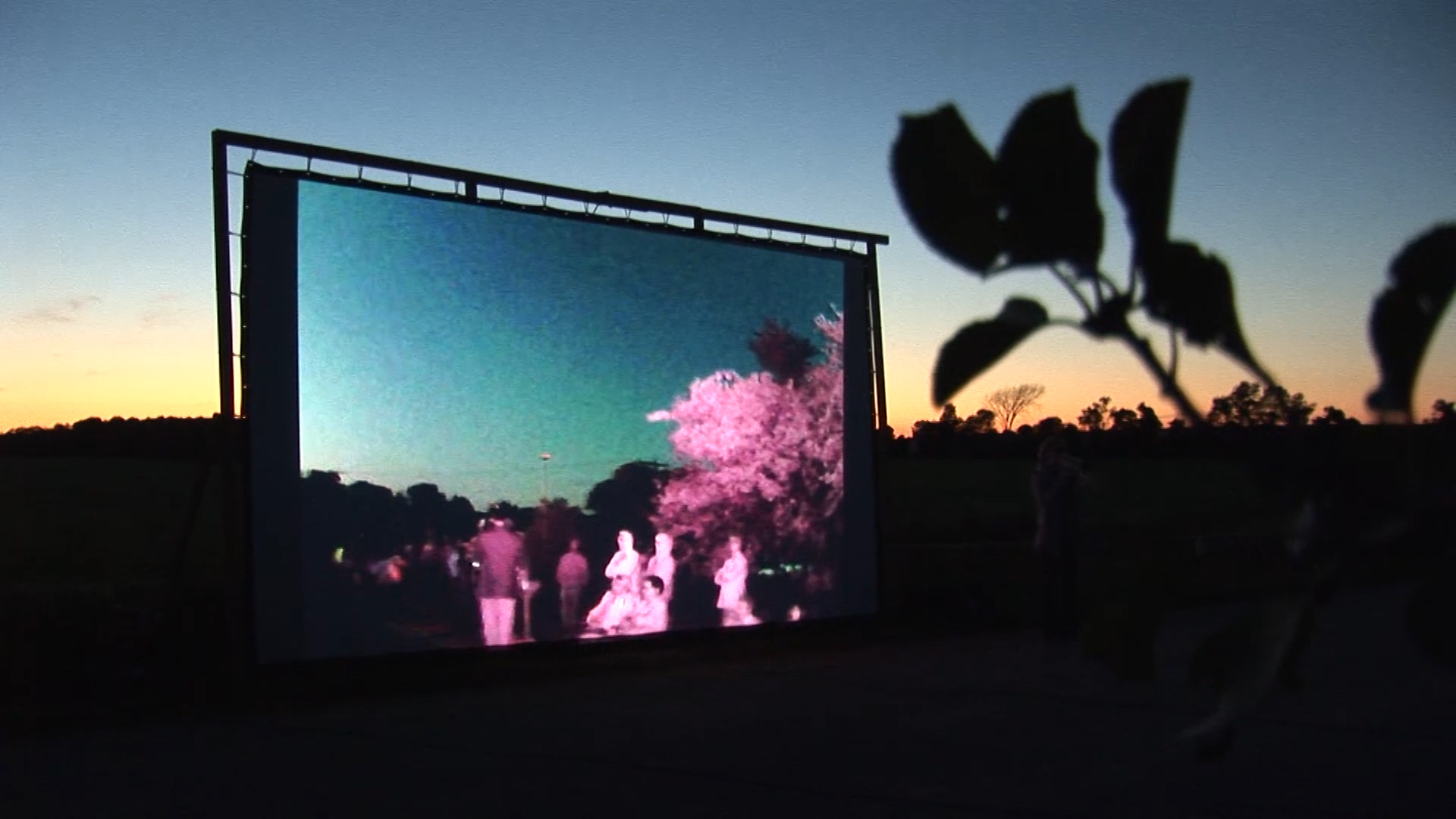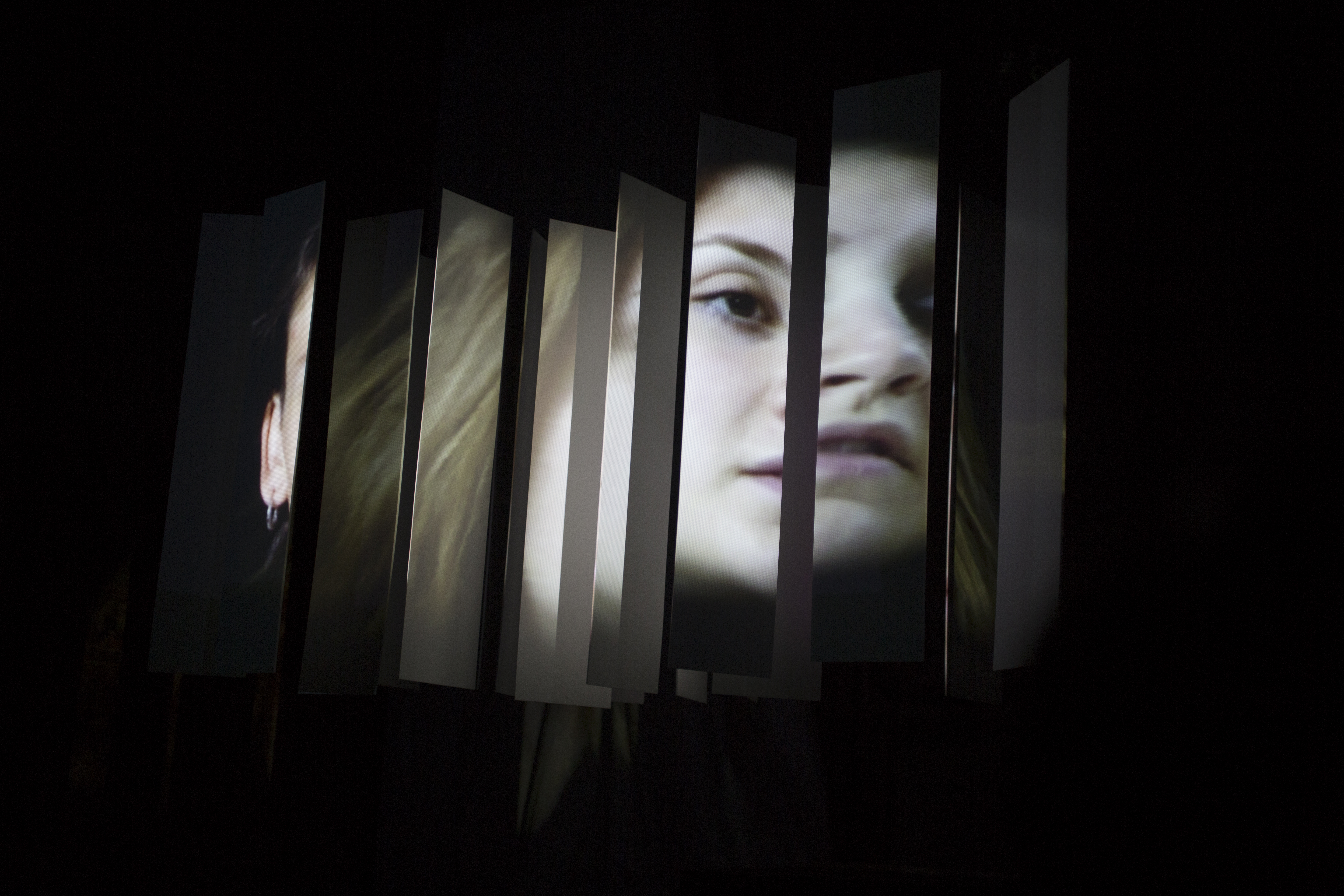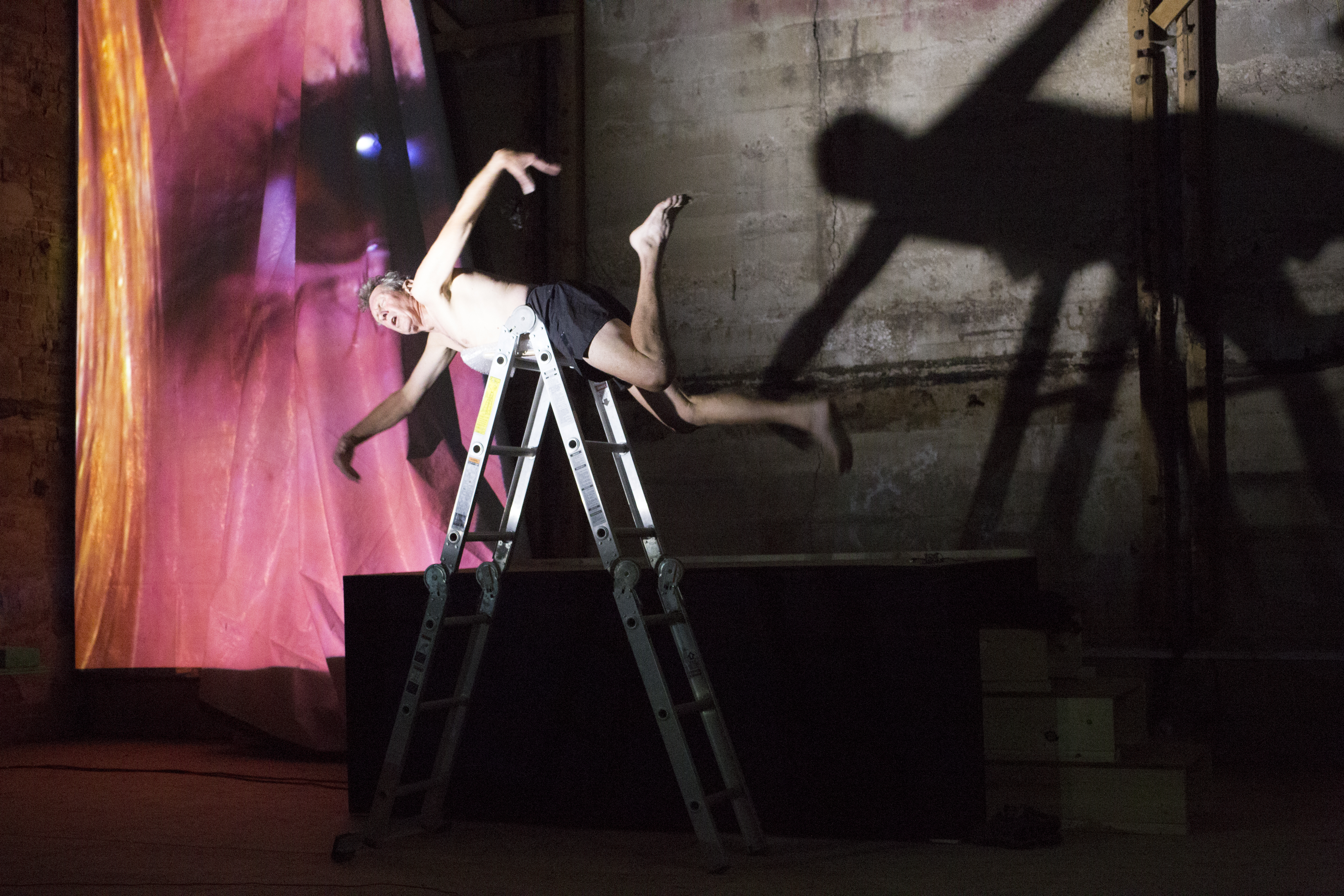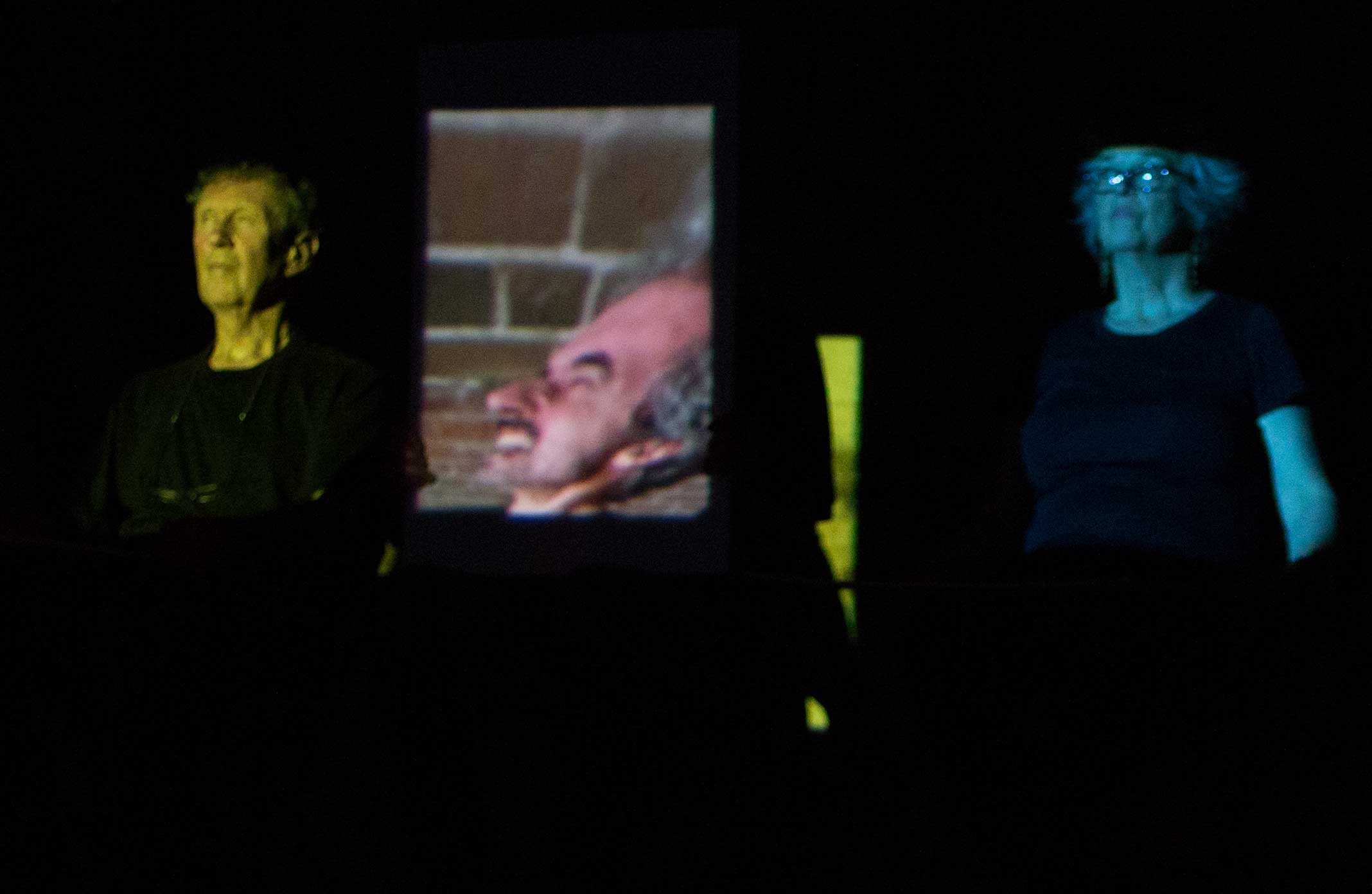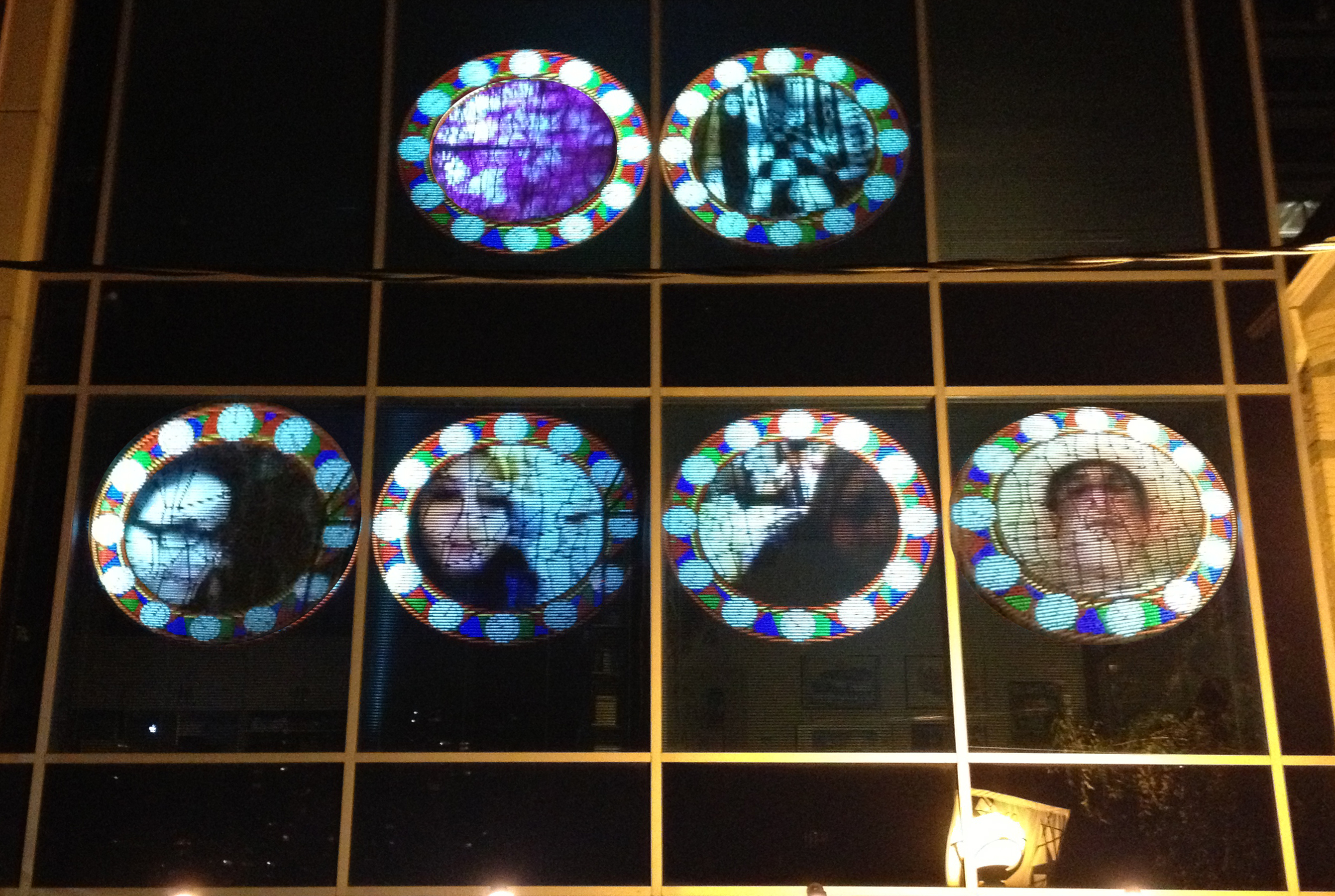Uncategorized
First Train / Last Train
A video installation and related works created by the Interference Ensemble: Anna Gruda, Tony Massett and Geoffrey Shea, with an original soundtrack by Mark Mariash.
The life-sized image of a freight train dominates the gallery space. Two screens, 10 feet high are six feet apart (roughly the dimensions of a boxcar) stretch almost from one end of the gallery to the other. They are positioned exactly where the tracks once lay on this former railway property.
The gallery’s front door faces the wooden trestle bridge across the street that clearly implies the direction of the now abandoned tracks and the rail traffic that used to stream back and forth into town and beyond. First Train, Last Train presents a collective, community memory of the train that used to run through Durham until the 1970s.
This installation recreates the scale of these noisy machines, and provokes a remembering, infused with imagination. An uninterrupted stream of goods, passengers, cattle, produce, industry, agriculture and employment reflect the narratives of life’s cycles. We are inviting the viewer to create their own geo-specific mental image of a moment 50 years ago, when the last train would have barreled down the track precisely in this location.
The sound that fills the space was created by our percussionist friend Mark Mariash. He used industrial materials to complement the instruments in his studio to create an extremely visceral experience.
We look back at the “first” film ever shown, also about a train: L’arrivée d’un train à La Ciotat (1895) by the Lumiere brothers. Anna wrote a text that creates reflections, both in its form and in the parallels between the two filmmaking experiences.
The exhibition also includes recorded interviews with local residents about their recollections of the trains.
Parade: The Journey
The final work in a trilogy about parades, presented at the Fabulous Festival of Fringe Film. It’s a three-channel video installation combined with a looping performance and featuring musical and performance collaborators from within the local community.
 Debbie Ebanks, the Festival’s co-artistic director:
Debbie Ebanks, the Festival’s co-artistic director:
“Interference Ensemble – led by artists Geoffrey Shea and Tony Massett – embarked upon a year-long journey re-interpreting community parades within the context of changing demographics in the rural social landscape. In the process, they are creating parades for the 21st century – transforming a familiar custom by re-centring the public and collective experience of community within individual narratives. The foregrounding of the hyperlocal context involves a changing set of community members and geographical locations well-known to locals. Outsiders may experience the multimedia abstract performances as spectacles in and of themselves, but it’s the people living here in Durham and surroundings that can nod knowingly at Interference Ensemble’s familiar yet odd vignettes of life in this rural town.”
Special thanks to:
Heather Saumer, Steve Morel, Jim Grant, Hana Fortin, William Bossi, Chris Palmer, Jenny Parsons, Marc Fortin, Surya Leigh Mellor, Judith Ketcheson, Oshun Batten, Zoë Vine, Doug Tielli, Nik Cherry, Rob Hodgson, Tony Luciani, Milan Radan, David Sugarman, Ahvin Torra, Michael Tweed, Ruth Webber, Jane Dover, Karen Poce, Anna Gruda, David Amonite, Riverside Fish & Chips, Durham Soccer Club, Garafraxa Café, Ontario Arts Council.
Parade at Art Spin Hamilton
The Parade is part sculpture, part musical performance and part community event. It’s part of a series by the Interference Ensemble, led by Geoffrey Shea and Tony Massett. Ten lightweight sculptures mounted on bicycle-wheeled floats are poised at the edge of an industrial parking lot. Visiting participants are invited to strap one of the floats to their waist and to pick up one of our drums. Once equipped and arranged, we will set out for an improvised musical performance as the newly formed band tramps around the ad hoc parade grounds.
Musical direction by Heather Saumer.
Thanks to organizers Jordyn Stewart and David Trautrimas.
Tethered Together
The first in a series of parade-themed performances by the Interference Ensemble, led by Geoffrey Shea and Tony Massett. This spectacle allowed us to explore aspects of public and private expression in a small-town setting. We formed a 12-piece brass band and commissioned new music to be performed in a local Christmas parade. (The Holstein Parade is famous for being completely non-motorized.) We created rolling floats with sculpted creature/passengers to be pulled by each musician. The entire performance was live streamed and projected into the Durham Art Gallery where a performer sang and spoke and interacted with the parade.
Music by Doug Tielli
Performance by Heather Saumer
The Durham Sauntering Band consisted of Grace Bridgman, Doug Tielli, William Bossi, Jim Grant, Basha Mayo, Dave Dunn, Robin Rich, Jenny Parsons, Steve Morel, Chris Palmer, William Bossi, Tony Massett and Geoffrey Shea.
Special thanks to Jane Dover, Holstein Parade, Durham Art Gallery, Akimbo Art Promotion and Ontario Arts Council.
Most of the Sauntering Band playing from the parade repertoire
at the Garafraxa Cafe




Triangulation
Triangulation was a 60-minute, live-video production created with the Interference Ensemble and presented in a hockey arena as part of the Fabulous Festival of Fringe Film. It slips out of Shakespeare’s King Lear, develops a new twist on the characters’ motivations, then rejoins the dark drama before it reaches its grisly conclusion. The performance weaves together several themes regarding parenting, social hierarchy and death. The three daughters are played by women who are able to exist outside of the play and engage in a reading of the characters born of a male writer’s imagination.
Blood Red
One part of an evening of word and sound performances at the Garafraxa Cafe, by members of the Interference Ensemble.
Concession 2: Surveillance
A pop up video performance on the side of a country road near a small town in Ontario.
Created together with Tony Massett in collaboration with Grace Bridgman and with music and performances by Heather Saumer and Doug Tielli.
This unsanctioned event revolved around the mysterious discovery of hidden surveillance cameras on the Second Concession of Glenelg (Concession 2 EGR, West Grey) just outside of Durham. We expect to be under scrutiny, observed, surveilled and even recorded in our daily urban journeys. But the discovery of these cameras, and an examination of the footage on them, is still a shock to the system.
Videos by Date
Part of a series of highly personal one-minute videos, each connected to a specific day of the year.
July 15 (Tennis) – Text by Tony Massett. Read by him and Grace Bridgman.
August 5 (Drink) – The pros and cons of intoxication.
January 4 (Princess Margarita) – The pizza is named after the Italian patron of the arts.
July 18 (Surveillance) – Creepy nighttime activities are caught on camera.
May 25 (Punk) – An improvised music session as refined as a board full of nails.
March 15 (Ides of March) – The middle of the month proved hazardous for Caesar.
August 31 (One Wedding and a Funeral) – The new stages of a life are contrasted with the old stages.
February 4 (Parliament Fire) – A postcard depicting the 1916 fire seems out of place.
September 20 (Birth and Death) – My son’s birthday is the occasion for spinning a mystery story.
December 5 (Slats) – Shadows on a louvred door, late in the year.
January 1 (Frost) – Patterns and noise flow together.
April 20 (Platform Change) – Announcements at the train station.
November 9 (Storm)
Gusts gash gorey gales
Wings whip where wind worries
Breezes bring back bitter boats
Storms string straight standing stories
November 9th needs no name
Clouds clamour clicking clucking
Days done dangling dimmly
Flicking flinging fasting fucking
Three Videos on Roads
Rural residents have a notable relationship with the roads we drive or, occasionally, walk. These video projects use repetition to make the point.
Sixteen Mile Lane
Marching Band (Triptych)
Grey Road 124 (Surveillance)
3 Minutes of Attention
Created with Tony Massett as part of the Correspondence project by the Interference Ensemble.
“For a long time I like you and every day I see how you get out of the house. I cannot seem to have the courage to come to you. I badly want to meet you. Hesitation over how to meet you. I came up with the idea to record a video clip for you. I’m asking you to give me three minutes of attention and watch this video clip. I know that after watching the movie you immediately recognize me. The video was posted on my personal page. I beg you to register on the site and find me there.”
Special thanks to Phaedra Tettero-Crosby
Correspondence
Correspondence is a 70-minute, live-video production, created in collaboration with Tony Massett and Grace Bridgman. It revolves around two stilted and strange romantic letters written a hundred years apart. We interact with pre-recorded and live streaming video to create an evolving understanding of the letter writers’ identities and motives.
“Some time ago, nearly two weeks, you sent me a postal card saying that you were going to write to me that night, but unfortunately, up to this date, no letter has come to hand. It seems to me that you are not at all careful in promises you make and break. If someone asked you to accompany them on a stroll or theatre engagement on a certain night and you promised you would and then didn’t, it would hardly be a very good recommendation for you, but what is the difference?”
The first of the letters was written to a young woman (my grandmother) by an older man in 1915 and reveals an unbalanced and inappropriate longing expressed as belligerent complaint. The sender’s identity remains a mystery. Exactly one hundred years later, another letter arrived:
“For a long time I like you, and every day I see how you get out of the house. Every day I look at you from the window of his house and cannot seem to have the courage to come to you. I badly want to meet you. I came up with the idea to record a video clip for you. I know that after watching the movie you immediately recognize me.”
This second letter, in contrast, flatters and entices the reader. Its origin is suspect but it promises online intimacy by leveraging voyeurism and fetishizing surveillance. Both letters use a formal and precise tone: one to suggest superiority through exaggerated language, the other to feign naïve innocence through broken English.
Plastic Houses
This 30-minute meditative film is a reflection on consciousness and community: the things that bind us to others and keep us apart. It was shot in Jungle Village, a training facility maintained by the New Tribes Mission for preparing missionaries for overseas work. The two characters, while clearly in some kind of relationship, exist as kinds of figments in each others imaginations.
The Jesuit missionaries in my own family struck me as exceedingly kind and conscientiousness individuals and it is very hard for me to reconcile that image with the culturally destructive role that missionaries have played in indigenous societies throughout the world. The chasm that separates religious and intellectual proponents at both ends of the spectrum in North America is one instance of the mystery surrounding the difference that our tenuous understanding of consciousness and community generates.
I am very grateful to Michael Tweed (camera) and Sonja Posod (my co-performer) for their commitment, trust and interpretive talents. PJ Dean-Thornton sang the song that I wrote and Tony Massett contributed his improvisations on the sax to the original music.
Trio
A group of folk musicians strum and pluck and croon away to a familiar ditty while viewers using cell phone swap players and instruments to create their own arrangement. Premiered at Nuit Blanche in Toronto, where over 3,000 viewers called in to re-arrange the musicians and the song!
“I chose to showcase folk music because of its politics of participation and inclusion. Folk was started by people who felt like they had something to say, who wanted to get involved. As a genre, it puts less emphasis on technique, and makes music more accessible.
“Everyone is getting creative with digital media these days, so I see media art as the new folk art.
“We’re increasingly surrounded by large public screens, and I’m hoping that not all of these will be advertising. People should have access to them, be able to play with them and inject their own content. I want people to leave feeling empowered, and that they might want to try something like this on their own.” (from interview with Jordan Bimm)


